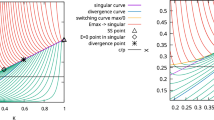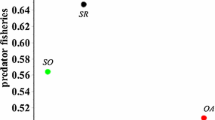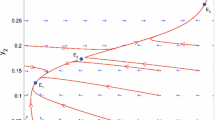Abstract
Consider an offshore fishing grounds of size K. Suppose the grounds has been overfished to the point that net revenue has been driven to zero and the fishery is in open access equilibrium at (X∞, Y∞). A marine sanctuary, where fishing is prohibited, is then created. Suppose the marine sanctuary is of size K2 and that fishing is allowed on a smaller grounds, now of size K1, where K1 + K2 = K. In the first, deterministic, model, the present value of net revenue from the grounds-sanctuary system is maximized subject to migration (diffusion) of fish from the sanctuary to the grounds. The size of the sanctuary is varied, the system is re-optimized, and the populations levels, harvest, and value of the fishery is compared to the 'no-sanctuary' optimum, and the open access equilibrium. In the deterministic model, a marine sanctuary reduces the present value of the fishery relative to the 'ideal' of optimal management of the original grounds. In the second model net growth is subject to stochastic fluctuation. Simulation demonstrates the ability of a marine sanctuary to reduce the variation in biomass on the fishing grounds. Variance reduction in fishable biomass is examined for different-sized sanctuaries when net growth on the grounds and in the sanctuary fluctuate independently and when they are perfectly correlated. For the stochastic model of this paper, sanctuaries ranging in size from 60 to 40% of the original grounds (0.6 ≥ K2/K ≥ 0.4) had the ability to lower variation in fishable biomass compared to the no sanctuary case. For a sanctuary equal to or greater than 70% of the original grounds (K2 ≥ 0.7K), net revenue would be nonpositive and there would be no incentive to fish.
Similar content being viewed by others
References cited
Allison, Gary W., Jane Lubchenco & Mark H. Carr. 1998. Marine reserves are necessary but not sufficient for marine conservation. Ecological Applications 8(1) Supplement: S79–S92.
Botsford, Louis W., Juan C. Castilia & Charles H. Peterson. 1997. The management of fisheries and marine ecosystems. Science 277(25 July): 509–515.
Clark, Colin W. 1990. Mathematical bioeconomics: the optimal management of renewable resources (2nd ed.). John Wiley & Sons, Inc., New York.
Food and Agriculture Organization of the United Nations, 1995. The state of world fisheries and aquaculture. Fisheries Department, FAO, United Nations, Rome.
Gordon, H. Scott. 1954. Economic theory of a common-property resource: the fishery. Journal of Political Economy 62:124–142.
Hall, Stephen J. 1998. Closed areas for fisheries management—the case of consolidates. Trends in Ecology and Evolution 13(8):297–298.
Hannesson, Rognvaldur. 1999. Marine reserves: what would they accomplish? Marine Resource Economics 13:159–170.
Holland, Daniel S. & Richard J. Brazee. 1996. Marine reserves for fisheries management. Marine Resource Economics 11:157–171.
Holmes, Bob. 1994. Biologists sort the lessons of fisheries collapse. Science 264 (27 May):1252–1253.
Lauck, Tim, Colin W. Clark, Marc Mangel & Gordon R. Munro. 1998. Implementing the precautionary principle in fisheries management through marine reserves. Ecological Applications 8(1) Supplement: S72–S78.
Leslie, P.H. 1948. Some further notes on the use of matrices in population dynamics. Biometrics 35:213–245.
May, Robert M., John R. Beddington, Colin W. Clark, Sidney J. Holt & Robert M. Laws. 1979. Management of multispecies fisheries. Science 205:267–277.
Spence, Michael & David Starrett. 1975. Most rapid approach paths in accumulation problems. International Economic Review 16(2):388–403.
Author information
Authors and Affiliations
Rights and permissions
About this article
Cite this article
Conrad, J.M. The Bioeconomics of Marine Sanctuaries. Journal of Bioeconomics 1, 205–217 (1999). https://doi.org/10.1023/A:1010039031324
Issue Date:
DOI: https://doi.org/10.1023/A:1010039031324




